Repairing a rug jacket – with denim-like darning

This coat has a good story behind it, and is a nice one for Dry January I think, as it shows different ways clothes can be remade, repurposed and repaired.
I bought it at the workwear-oriented shop Jinji in Paris. It had been made by them under their in-house label, some of which re-used materials to make new garments, usually in Japan. This particular piece used an old Navajo rug, hence the distinctive double cross.
I actually found an old illustration featuring a similar rug, below: a cartoon mocking the kind of rich American that used to buy textiles like these at local trading posts.
Jinji had had the coat in their shop for a while, sitting on a mannequin. The rug had proved too thick for the construction and had eventually ripped in various places, including under the sleeves, in the collar and around the buttons. It wasn’t really for sale.
I loved it though, and was pretty sure I could repair it. So I asked to buy it and ended up taking it away that afternoon with a little trepidation, unsure how it would work out.
My first port of call was the tailor Fred Nieddu, as I knew he’d appreciate the piece and might know someone who could help. He put me onto David Claxton, who repairs denim as well as making his own.
The repair work I’m highlighting here is all David’s work, though Fred also helped with some functional points, such as lowering the hip pockets to make them more usable, and doing the same with an internal breast pocket.
Above you can see the state the coat was in originally. Although the cotton yarn is very coarse, being a rug it's quite loosely set, which means it has pulled apart at the stress points: seams, edges, button holes.
David told me he was initially unsure it could be repaired at all, because the seams were so far gone. The only solution might have been to cut down the material, under the arms for example, and sew new seams. But then the sleeve might have become too narrow.
However, he eventually decided to try putting pieces of black denim underneath, and stitching the existing material on top of that. This is the same method you’d use on a big rip in a pair of jeans, putting new material underneath and then darning over the top.
Below you can see in the inside and outside of the finished sleeve.
Repairing jeans like this is how David started out, at Levi’s bespoke under Lizzie Radcliffe. He usually uses denim, but also sometimes something softer like linen.
“A challenge is always matching the yarn to the denim, because the yarn won’t be the same kind of indigo dye that the jeans are made of - you have to anticipate how the denim and the yarn itself will fade,” he says.
With my jacket, David used a mix of red and black yarn, echoing the material. The white you can see along the seams is part of the original weave, which just became more prominent as the material pulled apart.
With denim, a specialised darning machine is often used with a cylinder to you sew onto. I’ve seen these before and they’re pretty cool - the material isn’t drawn through like on a regular sewing machine, so the sewer can move the material in any pattern they want. The cylinder is there to help slide material onto, such as the leg of a pair of jeans.
“I didn’t use that with this jacket, because the material was too heavy,” says David. “I was afraid the weight of it would pull the two sides apart and make the seams uneven.
He did use one similar method though. “The key to repairs like this is to spread out the density of the stitching,” he says. “You need a lot of strength around the break point, or the hole, but if you use that same density everywhere the material will become too stiff. So you reduce the density as you radiate out, to create flexibility.”
The jacket should now be stronger than the original because the material isn’t held together by a single seam, but almost made like a solid piece. And of course other repairs can be done in the future.
I’m pleased, because I rather like the design. I don’t wear many things that are this bold, but in these colours and this simple make, I like it. I find the way the sleeves are finished in blocks of black particularly pleasing, as well as the symmetry of the crosses.
It’s stiff to wear, but not uncomfortably so. I think anyone that has worn heavier, traditional tailoring or workwear fabrics would find it wearable. And touches like that in-breast pocket make it more functional.
I’ve shown it here with my vintage Levi’s and a Real McCoy’s sweatshirt, which are pretty standard for me and probably the default when trying out bolder pieces on top. You could even say - one for long-time PS readers - that it’s a workwear equivalent of The Italian Background.
The other clothes shown are a black PS watch cap, Alden snuff-suede boots on the Modified Last, and a white PS Tapered T-shirt.
David Claxton can be contacted for repair work on Instagram @claxies_official


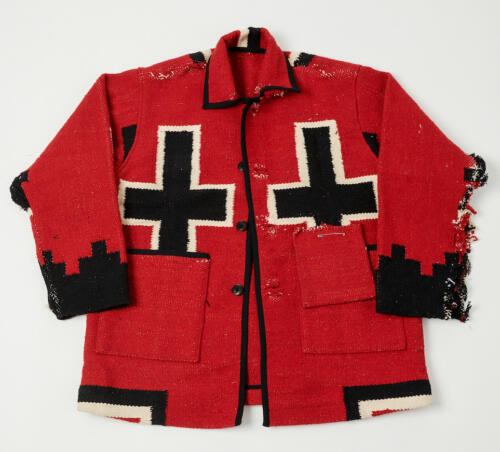
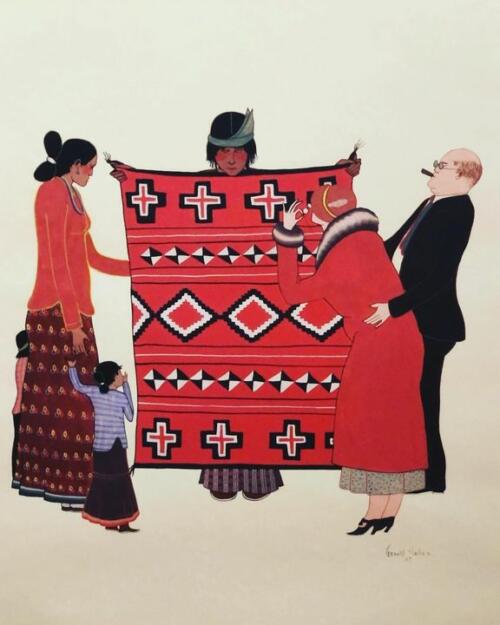
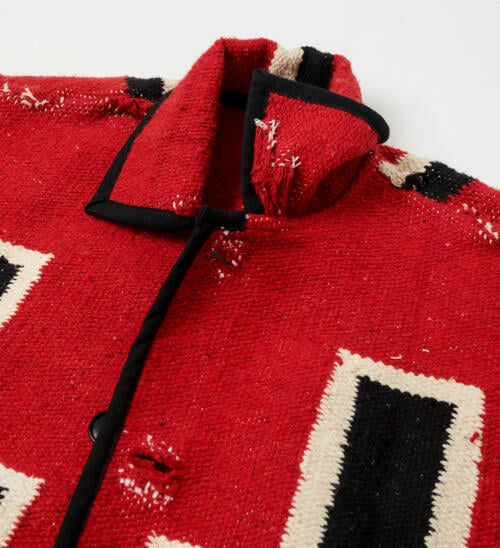
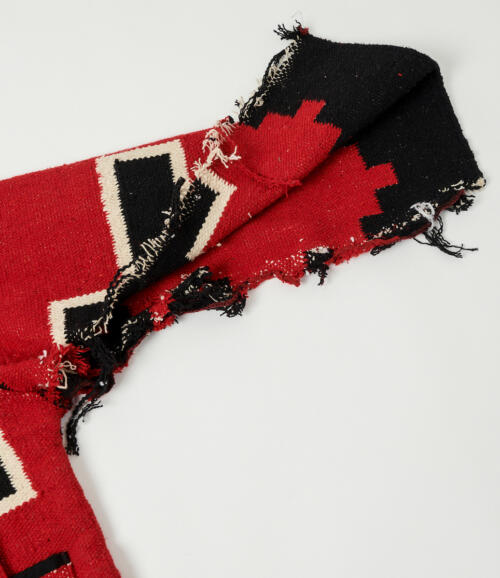
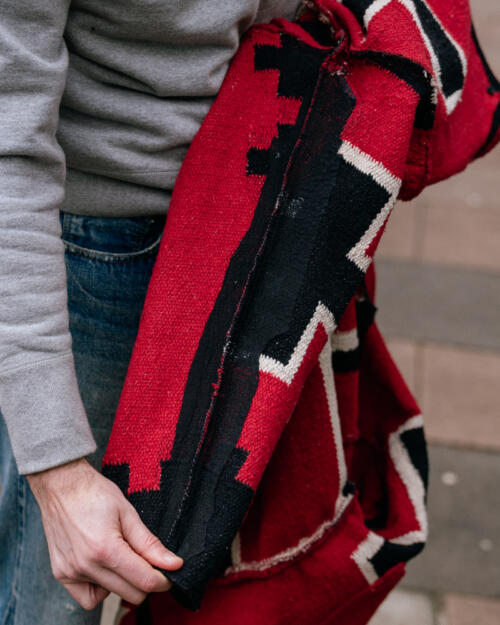
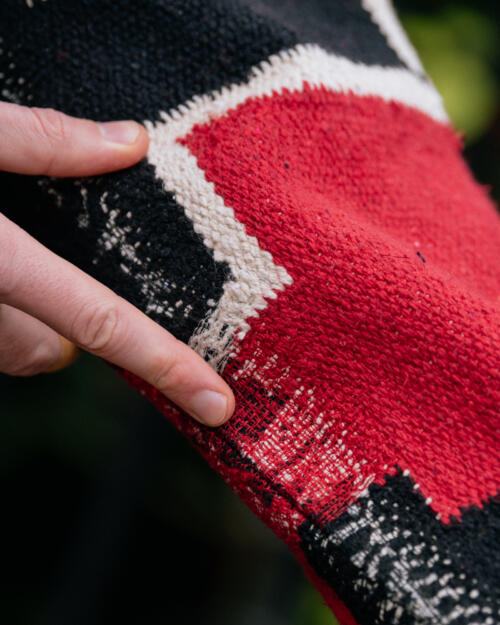
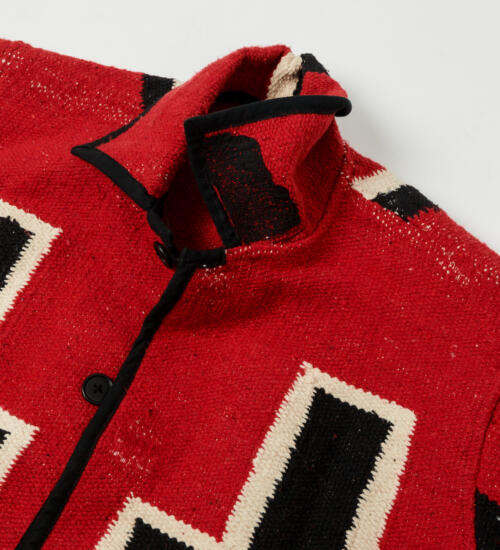
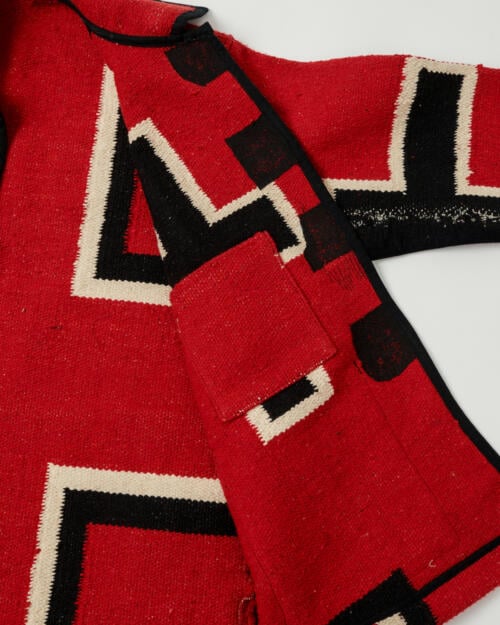
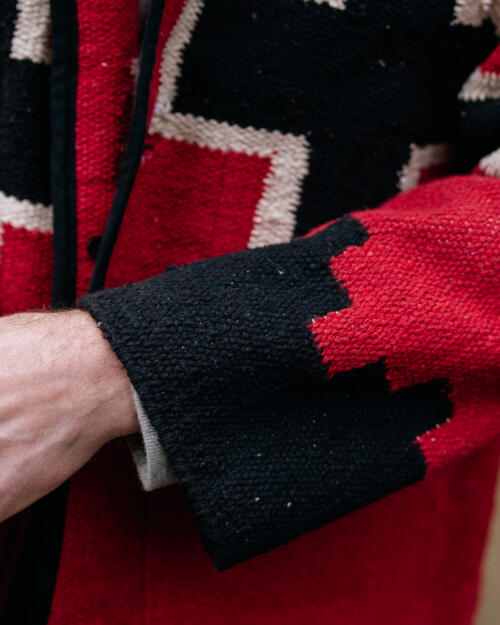
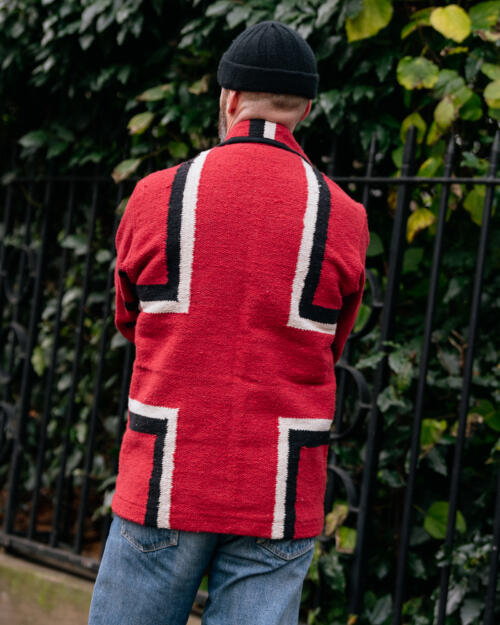
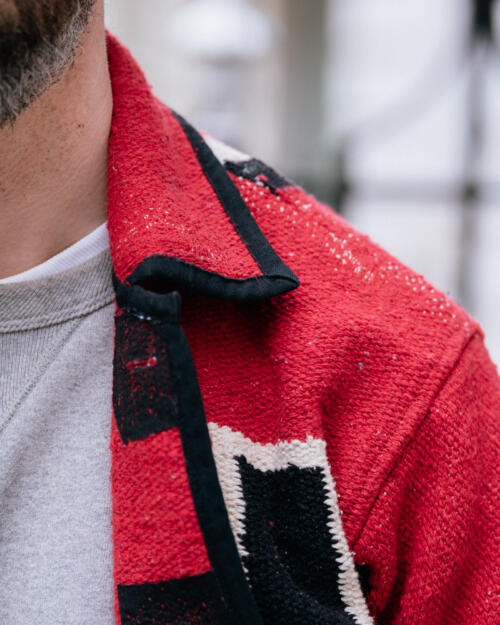
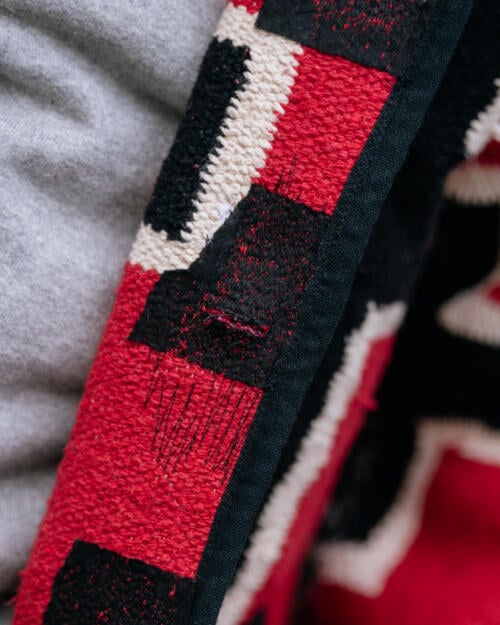


























When a garment gets to this stage of needing extensive repairs or whatever, if it’s not a sentimental or important piece, for me it becomes relegated to useful workwear and no repairs undertaken. I’m not a sartorially DIY repairman anyways.
Hi Simon, could you share the cost of the work? It’s admirable to give new life to something like this clearly, but I’ve found intensive repair costs like reweaving to be quite prohibitive, even when I was looking years ago.
Hey Sam,
Sure – the repairs cost £200, which I think was pretty reasonable given how much it made an existing coat wearable (and it had been bought at a considerable discount because it didn’t seem to any longer be wearable)
This is fantastic – both the coat itself and the repair work. And yes, it’s very bold, but I think you pull it off in style.
Thanks Robert!
Excellent piece Simon. I think your focusing on craft, restoration and the life cycle of clothes, shoes and accessories is a really useful antidote to over consuming and understanding that these things just get much better with age.
I’m curious, was anything further known about the rug’s provenance (ie, date of make) other than its tribal origin? A very beautiful piece, glad to see it saved.
Thanks Eric. No, it was just bought vintage.
Hi Simon, Whilst such an extensive repair is not something I would do, I do admire your imagination and perseverance. The takeaway for me is that it’s sometimes worthwhile taking on some (albeit not necessarily to such an extent) repair work if the prices work.
You are very unlikely to meet someone wearing another one!
Thanks, and yes I think that’s right. I hope that showing how such extreme repair work can be done also encourages others to do the small things – the darning, the little alterations that continue the life of something too
Love seeing repair work being mentioned and highlighted, great article and great looking jacket.
Also knowing how much you paid for (via another comment on here) the repair is encouraging, I would have expected it to be more given how much needed to be done.
Thanks Manuel.
Yes I think it helps that David works very much on his own – this isn’t going to some larger company, or somewhere with retail premises to pay for. I’d highly recommend him though, and will add him to our Clothing Resources post for future readers’ reference
Very informative story. Too bad you cannot show it to the original store who sold it to you?
Thank you. I will hopefully do so at some point. I saw them last week in Paris and told them about how it had been refurbished
I love the spirit of this. There is something universally human in being moved by something really worn down (even if it was not you that did the wearing.) Many people do this with used cars, houses, watches and furniture. I would say that the general populace doesn’t do this much with clothes. But I think that’s started to change as well.
I agree. Hopefully pieces like this appearing alongside new luxury clothing also reinforces that message
The photo from the back reminds me of David Bowie’s Union Jack coat, from the cover of the Earthlings album.
Do you know what exactly is being mocked in the old cartoon? Also, I was wondering if you had a post about appropriation, a bit like the recent one on stolen valour. There is some interesting discussion of it in the comments to the post on Navajo weaving, but I can’t find a follow-up article.
I never thought of that, thanks.
I think it’s the rich city dwellers that are being mocked – their primness and pretence of examining the work – given the way caricature-like way they are drawn and the expressions of the Native Americans, plus the inclusion of the mother and children on the left. But it would be good to know what context it was presented in.
Good point on appropriation, that’s definitely something we should cover in a similarly journalistic way to the articles on stolen valour and things like fur. Particularly given the recent Ralph Lauren campaign, attempting to redress their public image by working with actual Native American designers
Not to stir up too much trouble here… but Ralph Lauren, a Jew, certainly appropriated WASP culture — my goodness, did he ever — and did very well for himself in the process.
Through a positive lens, one might credit him, whatever his background is, for keeping a culture alive, celebrating it.
Personally, I squirm when clothing brands, places like Starbucks, etc., move into politics or take on what appear to be altruistic projects.
I’m not saying they’re doing these things for cynical marketing purposes… only that clothing brands, coffee brands, etc., should stick to just that, making clothes, maintaining quality coffee shops and so on. Maintain ethical standards but don’t tell the world what well meaning sorts you are. There’s a wrong move in doing that — it’s hard to describe.
Of course, just as some upper-crust types in the cartoon examined an Indian blanket, so, in real life did the American Indian “appropriate” the white man’s guns and horses. Lots of back and forth.
Thanks Leif. Personally, I think it’s a good thing that companies take those kinds of positions – or rather, feel they are forced to by the opinion of their customers. I think it’s one of the few effective breaks on capitalism outside of regulation. But that’s a big discussion and this is not the right forum
Fully understood.
Back to the clothing itself… I really like the idea of a project like this, taking something that sat almost as a museum piece and bringing it back to life as a wearable piece.
Very roughly along these “project piece” lines, I found on etsy a hat maker that does a great job of making vintage style ball caps or “mechanics” caps as they call them. Fortunately for me, they make them in larger sizes. You can send them any workable fabric and they’ll fashion it into a nice ’30s/ ’40s era, short billed worker’s cap.
Great article! It’s easy to think of fabrics or textiles as only having “one purposes” when they can sometimes be skillfully repurposed.
On that note, a perhaps more mundane question: what are some solutions to “crouch blowout” in trousers, specifically in tailoring fabrics like worsted wools or flannels? Is patching an acceptable solution given this area isn’t so prominent?
Yes, they can certainly be patched. I’ve done that before. The key is to try and catch it before it completely goes through, so it’s just very thin. That way the cloth behind will barely show. But even if it has gone through, you should be able to get something very close and patch it from behind
Good to know! I had only had it done for jeans before but have trousers from a Ring Jacket suit I’d love to wear again which have blown out, unfortunately with a unique subtle stripe.
Any recommendation for who could do this repair in London? Thank you.
Any good alterations tailor – see our list here
Fantastic, thanks a lot for the insights and the link. Based in London myself, it’ll be very useful!
Oh good
This is GORGEOUS Simon. Love you going bold.
Fantastic coat, and great job salvaging it
What an awesome jacket, and all the more given the story behind it and impressive repair work put into it!
Somewhat unrelated aside, but I recently picked up a Real McCoys 10oz loop wheel sweat, and after a dozen or so wears it has gone very bally. This is my first sweatshirt of this nature, and I would have expected more – have I missed something here (ie. is it a result of the manufacture process), or is it worth getting in touch with the team?
Always appreciate your work, thanks Simon!
Interesting, I wouldn’t expect that Austin. You mean like pilling?
Cheers for the response Simon. That is exactly it – there is quite bad piling around the underarms and lower torso (effectively the high contact/friction areas).
Good to know that this isn’t common though, I’ll reach out to the team and get their feedback on it, hopefully just a minor issue with one batch!
What a neat project this was and the final results are great: a jacket that is unique in the best way, an attention getter yet tasteful, like some late 1800s American Indian blanket coat.
Cheers Leif, pleased you like it